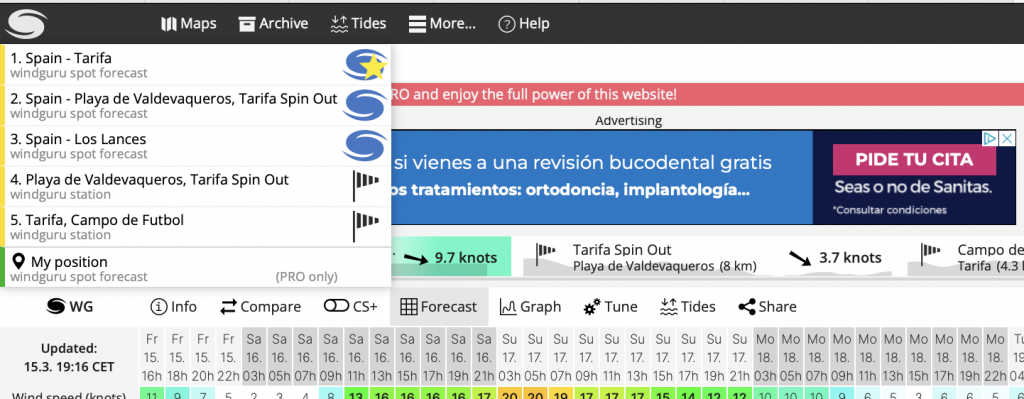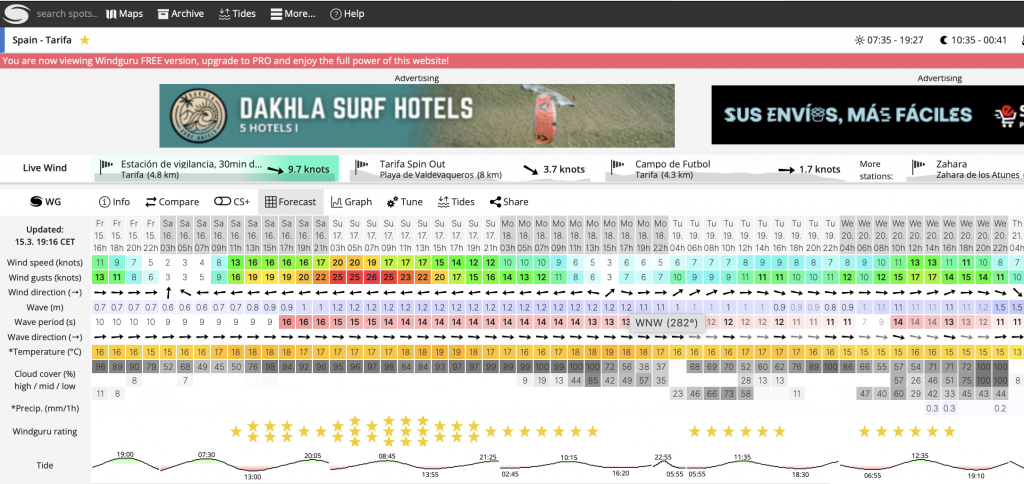The ability to read and understand wind predictions is paramount for both the safety and enjoyment of this exhilarating sport. In this blog article, we’ll guide you through the process of reading the most popular wind predictions for kitesurfing, ensuring you’re well-prepared for your next adventure on the water.
Understanding Wind Predictions
Wind predictions provide forecasts about wind speed, direction, and gusts. These forecasts are crucial for kite surfers who need to know the conditions they will be facing. Here are some of the most popular sources for wind predictions:
- Windguru: Highly favored among water sports enthusiasts, Windguru offers detailed forecasts that include wind speed and direction, wave height, and other pertinent weather conditions.
- Windy app: Offers comprehensive and interactive wind forecasts with a visually appealing interface. Windy also provides weather overlays for clouds, rain, and temperature, making it a versatile tool for planning your kitesurfing sessions.
- Windfinder: Windfinder is widely recognized as a valuable resource for sailors, surfers, kitesurfers, windsurfers, and other water sports enthusiasts, as well as for professionals involved in maritime activities.
Reading Wind Predictions in Windguru
For the purpose of this article, we will be diving into the most accurate source in Tarifa: Windguru.
Reading wind forecasts on Windguru can initially seem daunting due to the comprehensive data presented, but once you understand the layout and what each section represents, it becomes an invaluable tool for planning your kitesurfing sessions. Here’s a step-by-step guide to help you navigate and interpret the wind forecasts on Windguru:
1. Choosing Your Location
First, you need to select your specific kitesurfing location. Windguru has an extensive list of spots worldwide. You can use the search function to find your spot or browse through countries and regions. For Tarifa, you can choose directly “Tarifa” or “Los Lances” or “Valdevaqueros”. I personally prefer to keep Tarifa as my location for planning kite surfing lessons.

2. Understanding the Forecast Table
Once you’ve selected your spot, you’ll be presented with a forecast table. This table is divided into several columns, each representing different aspects of the weather. The most crucial columns for kitesurfing include:

- Date and Time: The forecast is usually divided into 2-hour intervals, providing detailed predictions throughout the day. Wind forecasts lose their accuracy after the 48h span. In this example, the likelihood of Monday wind to be actually like this is really low. While we can expect accurate predictions for Saturday and Sunday.
- Wind Speed: Typically displayed in knots, this indicates how fast the wind is expected to be. The wind speed is color-coded, with different colors representing various wind speeds. Blue to green colors usually indicate lighter winds, while yellow, orange, and red represent stronger winds. In this example of wind prediction for Tarifa: on Saturday, we will have 16 to 19kts of East wind from 1pm. Pretty much a dream!
- Wind Gusts: Gusts are sudden, brief increases in wind speed and can significantly affect your control over the kite. In Windguru, gusts are also listed in knots. A small difference between the wind speed and wind gusts indicates a nice, stable wind.
- Wind Direction: This is shown with small arrows that point in the direction the wind is blowing towards. Understanding wind direction is crucial for identifying safe and favorable kitesurfing conditions. In this example, the arrow coming from the right side indicates East wind, which for Tarifa means the famous Levante wind.
About Waves
- Wave (m): a very important element to plan your kite session. Windguru measures it in meters. In this case, a 0.7m indicates small wave
- Wave period: Measured in seconds, the wave period refers to the time interval between successive waves. A longer period means the waves have traveled a longer distance, often resulting in more powerful and better-formed waves that are preferable for surfing and kitesurfing too.
- Wave direction: This indicates where the waves are coming from, usually represented by an arrow or degrees (°). In this example of Tarifa’s wind prediction, waves coming from the opposite direction of the wind indicates a nice and well-formed wave, paired with a nice period of 16 seconds.
More general weather
- Temperature: While not directly related to wind, the temperature can affect your comfort and the gear you choose to wear.
- Cloud Cover and Precipitation: Represented in percentages and millimeters, respectively, these columns give you an idea of the weather conditions, which can influence your decision to go kitesurfing.
- Windguru Rating: with more stars, indicating better conditions for the activity in question. The number of stars is determined based on a combination of factors including wind speed, wind direction, wave conditions, and sometimes temperature.
- Tide: times for high and low tides are listed, allowing users to plan their activities around these periods. High tide is when the sea level is at its maximum height within the tide cycle, while low tide is when the sea level is at its minimum.
3. Analyzing the wind predictions
- Look for consistent wind speeds within your skill level. For beginners, 14 to 25 knots is ideal.
- Pay attention to the wind direction arrows. Preferable conditions are when winds blow parallel to the shore (side-shore) or from the sea towards the land (side onshore).
- Note the difference between the average wind speed and gusts. A smaller difference is generally safer and more manageable.
- Consider the weather conditions (cloud cover, precipitation, and temperature) when planning your session.
A very important note:
- Windguru Live: If available for your chosen spot, Windguru Live provides real-time wind measurements, which can be incredibly useful for last-minute decisions. In Tarifa, this is not very accurate measurement, you always need to add at least 5 knots.

- Forecast Models: Windguru offers different forecast models (GFS, NAM, etc.). Each model has its strengths, and comparing their forecasts can provide a more rounded view of the expected conditions. The most accurate model for Tarifa is the WRF3km. “WRF3km” refers to a specific configuration of the Weather Research and Forecasting (WRF) model that has a spatial resolution of 3 square kilometers over the area of Tarifa. It only gives a 2-days range, which is the most accurate.

5. Final Tips
- Experience Over Time: Your ability to read and interpret forecasts accurately will improve as you gain more experience. Take notes on the conditions and your experiences to refine your judgment.
- Check Regularly: Weather conditions can change rapidly. Regularly check the forecast leading up to your session for any updates.
- Consult Locals: Local kitesurfers and kite schools like Tarifa Max Kitesurfing School can offer valuable insights into how accurate forecasts typically are for your location and what conditions you can realistically expect.


